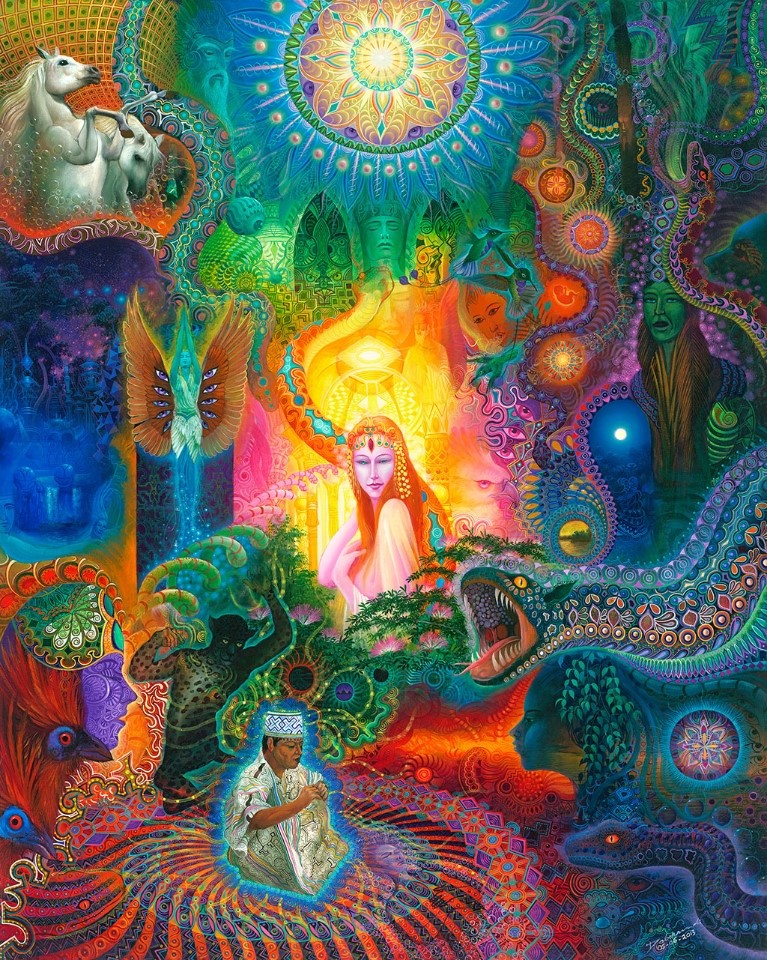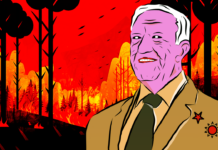When I entered Brazil’s National Museum as a master’s student in social anthropology, I knew only that I wanted to specialize in the anthropology of art and images; I did not know yet what specific object would be the theme of my research. It was then I remembered, suddenly, this remarkable exhibition I had visited a few years back in the city of Brasília. The exhibition, Mira! Contemporary Visual Arts of Indigenous Peoples (Mira! Artes Visuais Contemporâneas dos Povos Indígenas), displayed in 2014, presented the diverse artistic production of Amerindian peoples situated in different countries throughout Latin America. As I examined the catalogue of the exhibition and investigated, I could see the amazing iconography of Amazonian visionary painting unfold before my eyes.
In the last few decades, a new kind of art has been striking natives and tourists of Peruvian Amazonia with great wonder and enchantment: ayahuasca-inspired visionary art.
In the last few decades, a new kind of art has been striking natives and tourists of Peruvian Amazonia with great wonder and enchantment: ayahuasca-inspired visionary art. This very original iconography emerges directly from the artists’ visionary experience under the effect of the ayahuasca brew, which is common in the shamanic traditions of the region.
While some Amerindian peoples of Western Amazonia are famous for their graphic art in the form of geometric drawings made on ceramics and human bodies, figurative paintings are relatively absent in these traditional contexts. This historical fact, along with the great aesthetic beauty and complexity of the new Amazonian visionary painting, makes this kind of art a very interesting and an unexpected expression of this region’s indigenous and mestizo shamanic culture.
With the use of figurative techniques, sometimes learned in art schools or developed autonomously, mestizo visionary artists manage to translate and share their colorful supernatural visions with a much wider public than that directly involved with ayahuasca shamanism. One of the most important effects of this translation, in my view, is to render visible the invisible dynamics of shamanic worlds, even to untrained eyes.
this new phenomenon makes it possible for us to appreciate amazing images of physical and metaphysical worlds that otherwise would only be visible in the context of an intensive immersion in the ritual use of ayahuasca.
The larger political and cultural significance of this ongoing process is yet to be completely acknowledged. At the same time, this new phenomenon makes it possible for us to appreciate amazing images of physical and metaphysical worlds that otherwise would only be visible in the context of an intensive immersion in the ritual use of ayahuasca. Pablo Amaringo, Anderson Debernardi and Paolo del Águila are among the most prominent Amazonian visionary artists and painters.
The Pioneering Work of Pablo Amaringo
One of the central Amazonian artists to initiate the move towards fixating ayahuasca visions in the form of painting is Pablo Amaringo. He was born in 1943 in the region of Loreto, near the Ucayali River, one of the most important rivers in Peruvian Amazonia, and died in 2009.
Amaringo came from a family of vegetalistas, the mestizo shamans of the region who are experts in traditional plant medicine, especially the powerful ayahuasca brew. Although he was considered a mestizo, his family had kinship ties with different Amazonian indigenous groups, like the Cocama and the Piro. In his youth, Amaringo suffered from a disease which was cured through the plant medicine ayahuasca. From this moment on, he learned to draw and paint, and became a healer himself, instructed in the spiritual mysteries of the plants.
Initially, he did not paint his shamanic visions; instead, his artistic efforts were focused primarily on painting portraits and landscapes. This focus changed in the 1980s, after he met anthropologist Luis Eduardo Luna, who was doing research on Amazonian mestizo shamanism and asked him to draw some of the visions he had under the effect of ayahuasca.
As the quality of the works was quite high, in addition to their originality, Luna proposed a partnership with Amaringo for the publication of a book containing the latter’s paintings, along with some comments about the visions, made by the artist himself, and introductory texts authored by the anthropologist.
The result of this partnership can now be found in the book Ayahuasca Visions: The Religious Iconography of a Peruvian Shaman, published in 1991 (Luna & Amaringo, 1991)1 In its pages, the reader is delighted by the impressive images of the many spiritual realms visited by Amaringo.
After this collaboration with Luna, Amaringo became increasingly known in the art world, reaching larger audiences through exhibitions in Europe and the United States. In 1988, the two also founded an art school in Pucallpa, the second largest city in Peruvian Amazonia. This school, named Usko-Ayar (meaning “spiritual prince” in Quechua), functions even today, while transmitting the traditions and techniques of Amazonian painting to younger generations under the auspices of Pablo Amaringo’s work and its unique style.

The Shining Colors of Anderson Debernardi
His work has attracted great admiration for its colorful depiction of Amazonian animals, plants, and spirits, as seen in the context of ayahuasca rituals.
Among the pupils of Usko-Ayar, one of the most successful is Anderson Debernardi, who was one of its first students back in the late 1980s. He also taught at the school and had exhibitions in countries as far away as the United States and Finland. Debernardi was born in 1968 in Orellana, a small town near the Ucayali river in Peruvian Amazonia, and grew up between the cities of Iquitos and Pucallpa. His work has attracted great admiration for its colorful depiction of Amazonian animals, plants, and spirits, as seen in the context of ayahuasca rituals. Today, Debernardi is a consecrated visionary artist, whose work has gained attention both in Peru and abroad.

Paolo del Águila’s Supernatural Gift
Another prominent Amazonian visionary artist is Paolo del Águila, a descendant of the Asháninka people, who is also influenced by the shamanic tradition of the Shipibo-Konibo. He studied at the Escuela Superior de Formación Artística Pública Eduardo Meza Saravia” (school of fine arts) in Pucallpa, where he learned to paint in a Western style. He studied the classic works by artists like Leonardo da Vinci and Rembrandt, but, at the same time, he was in search of his indigenous roots. That was when he got closer to Shipibo-Konibo shamanism and received his artistic style as a gift from a spirit. His story is quite interesting to follow:
At school I graduated as an artist doing all the activities that the West teaches us, but in order to search for my identity, as I told you, the Shipibo brothers introduced me to the famous ayahuasca plant. The plant has been my true master. Before, I did not know about spiritual dimensions…. Finally, in an ayahuasca ceremony, in which for the first time I had contact with nature, I could realize the power of the harmonious circle I now perceive. In this ceremony, I could see an old woman who got close to me in a vision and gave me a wooden stick, saying: “Take your art”… On the other day, I talked to the shaman and he told me: “ayahuasca gives you your art.” It was then that I started to seek my own style and to understand the customs of Shipibo culture. I started investigating, and experimenting my own philosophy. (Translated from del Águila, 2014)2. Mundo Amazónico, 5, 267–272.]
This way, with the decisive intervention of the spiritual world opened by ayahuasca, the artist has managed to build his own style and techniques of visionary painting.

Making Visible the Invisible: The Power of Translation in Amazonian Visionary Art
Besides these three artists, approached very briefly in this article, many other men and women have been drawing and painting their ayahuasca visions in a phenomenon that has had an extraordinary development in the last decades. The diversity of aesthetic proposals echoes the cultural diversity of Amazonia itself, and expresses the incredible richness of Amazonian forms of expression, such as art and shamanic rituals.
Besides the ones more directly inspired by visionary experience, other artists have parted from traditional artistic practices of the region to propose new aesthetic forms. This is the case of Olinda Silvano, a Shipibo-Konibo artist who applies the kené drawings of her people to different surfaces, like murals.
In these works by Amaringo, Debernardi, and del Águila, mentioned above, at least one aspect of visionary art is made evident: its extraordinary power to render visible the invisible.
In these works by Amaringo, Debernardi, and del Águila, mentioned above, at least one aspect of visionary art is made evident: its extraordinary power to render visible the invisible. That may be considered one of the main reasons for its striking success. This art functions as a shining window to the spiritual worlds of ayahuasca shamanism, translating the multidimensional and extraordinary visions to our more familiar realm of everyday iconic images.
Art by Karina Alvarez.
References
Take a minute to browse our stock:
Did you enjoy reading this article?
Please support Chacruna's work by donating to us. We are an independent organization and we offer free education and advocacy for psychedelic plant medicines. We are a team of dedicated volunteers!
Can you help Chacruna advance cultural understanding around these substances?














